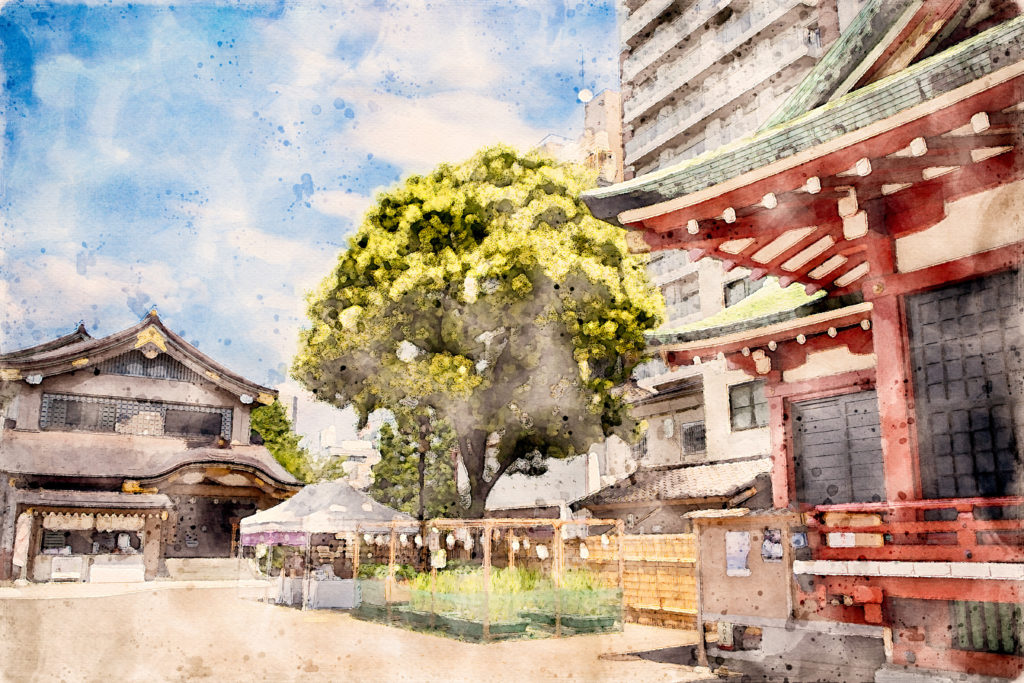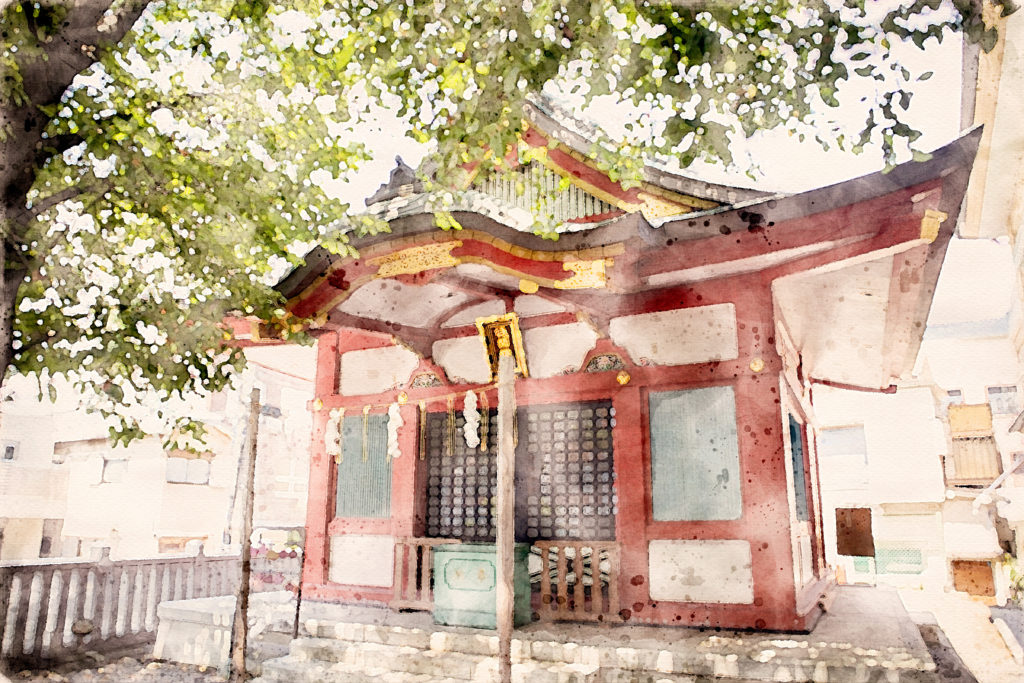The “Shrines and Temples” category of the Tokyo Shitamachi Guide presents Shinto shrines and Buddhist temples in Tokyo’s Shitamachi area, which is the area along and east of the Sumida River.
Each time, we recommend an engaging location for your sightseeing experience in Tokyo. In this article, we will focus on Asakusa Shrine, a Shinto shrine in Asakusa, Taito Ward.
Sensoji Temple, the oldest Buddhist temple in Tokyo, is situated right next to Asakusa Shrine. Until 1868, Asakusa Shrine and Sensoji Temple were part of the same religious institution, which means they have a longstanding connection.
Asakusa Shrine is dedicated to Sanja Gongen. That’s why the locals refer to this shrine as “Sanja-Sama” or “Lord Sanja”. Just to give you some background, Sanja Gongen represents the deified three founding members of Sensoji Temple.
Asakusa Shrine hosts an annual festival known as “Sanja Matsuri” every May. This festival is among the largest in Japan. It attracted over 2 million visitors in 2017, as mentioned on Wikipedia.
This article will provide clear and easy-to-understand information on various topics related to Asakusa Shrine, including:
- Historical background
- Enshrined deities
- Highlights
- Transportation options
- etc.
Reading this article will help you gain a better understanding of Asakusa Shrine. You can use it as a reference when you visit the shrine.
This article is also available in Japanese. You can access it at the following link:
History

According to Asakusa Shrine, its origin dates back to the 7th century. In addition, its history is closely related to Sensoji Temple, which is located next to Asakusa Shrine.
Around the beginning of the 7th century, there were two fisherman brothers named Hinokuma Hamanari and Hinokuma Takenari.
On March 18, 628, the Hinokuma brothers were fishing in the Sumida River when they discovered a Buddha statue tangled in their casting net. However, they had no idea what it was at the time.
The Hinokuma brothers showed the statue to Haji Manakachi, a samurai residing in Asakusa. He pointed out that this Buddha statue was Sho-Kannon Bosatsu.
According to Buddhism, Kannon Bosatsu, a Buddhist deity of compassion, changes into various forms to empathize with the suffering and wishes of many people. Sho-Kannon Bosatsu represents its original form.
The Hinokuma brothers, along with the locals, constructed a modest Buddhist temple dedicated to Sho-Kannon Bosatsu.
Later, Haji Manakachi became a Buddhist monk and converted his residence into a Buddhist temple. He dedicated the temple to the statue of Sho-Kannon Bosatsu there. This is the beginning of Sensoji Temple.
In the 12th century, the descendant of Haji Manakachi received a divine message from Sho-Kannon Bosatsu, which conveyed the following:
Your ancestors saved me from the water and erected Sensoji Temple as a dedication to me. Their remarkable deeds deserve recognition.
Therefore, enshrine them as local deities called Sanja Gongen beside Sensoji Temple. This will bring about even greater prosperity to this area.
The descendants of Haji Manakachi and the Hinokuma brothers enshrined their three ancestors as local deities. This is the beginning of Asakusa Shrine. During that period, the shrine was known as Sanja Gongensha, meaning the shrine of Sanja Gongen.
In 1868, the Meiji government issued the Shinbutsu Bunri policy. This policy attempts to eliminate any Buddhist influence on Shintoism.
In that very year, Sanja Gongensha gained independence from Sensoji Temple. And it concurrently underwent a name change to Sanja Myojinsha. In 1873, Sanja Myojinsha further changed its name to Asakusa Shrine.

Enshrined Deities
Sanja Gongen
The primary Shinto deity enshrined at Asakusa Shrine is Sanja Gongen. This is a collective term representing the deification of three individuals who played a significant role in the establishment of Sensoji Temple.
Sanja Gongen includes:
- Haji Manakachi
- Hinokuma Hamanari
- Hinokuma Takenari
Toshogu
Asakusa Shrine also enshrines Toshogu. Toshogu is the deification of Tokugawa Ieyasu, who founded the Tokugawa Shogunate. And Toshogu is also known as Tosho Daigongen.
According to Asakusa Shrine, this Shinto shrine began to enshrine Toshogu in 1649.
Toshogu is a Shinto deity dedicated to safeguarding the nation from disasters. The blessings associated with this deity include:
- Flourishing career
- Business prosperity
- Household safety
- Wish fulfillment
- etc.
Okuninushi
Asakusa Shrine also dedicates to Okuninushi, also known as Onamuchi.
In the Japanese mythological tale “The Hare of Inaba,” Okuninushi (known as Onamuchi at that time) provided medical advice to a hare. As a result, Okuninushi came to be revered as the god of medicine.
Okuninushi is the deity of nation-building, medicine, and marriage. The blessings associated with this deity include:
- Business prosperity
- Disease cure
- Marital harmony
- etc.
Ebisu
Asakusa Shrine also enshrines Ebisu, who is a member of the Seven Lucky Gods in Japan. Ebisu is identified with Kotoshironushi, another Shinto deity.
Ebisu is the deity of fishing and commerce. The blessings associated with this deity include:
- Abundant catch
- Business prosperity
- Economic fortune
- Household safety
- etc.
Ukanomitama
Asakusa Shrine also enshrines Ukanomitama at Hikan Inari Shrine, a small shrine located in the precincts of Asakusa Shrine. This deity is identified with Inari, another Shinto deity.
Ukanomitama is known as a goddess of grains, agriculture, and performing arts. The blessings of this deity include:
- Good harvests
- Business prosperity
- Household safety
- Improvement in performance art
- etc.
Konohanasakuya-Hime
Asakusa Fuji Sengen Shrine, another subordinate shrine of Asakusa Shrine, is dedicated to Konohanasakuya-hime.
This Shinto deity is a very beautiful goddess, symbolizing Mt. Fuji. It is said that the word “Sakura” originated from her name.
Konohanasakuya-hime is the deity of safe childbirth and child rearing. The blessings associated with this deity include:
- Fire calamity prevention
- Safe delivery
- Pregnant
- etc.
Highlights
The Shrine Building

In 1649, Tokugawa Iemitsu, the third Shogun of the Tokugawa Shogunate, built the shrine building of Asakusa Shrine.
This shrine building follows an architectural style known as Gongen Zukuri. This style of architecture interconnects the following three buildings under the same roof:
- Honden: The main building where the deities are enshrined
- Heiden: The building used for conducting ceremonies
- Haiden: The building designated for worship
Gongen Zukuri is a prevalent architectural style found in Shinto shrines during the 17th century.
The exterior walls of the shirne building are painted with Urushi lacquer, and spiritual beasts such as Kirin and Hiryu are designed in vivid colors. The shrine building had deteriorated over time, so it was repaired over three years in 1961 and 1994.
Asakusa Shrine’s building has escaped damage from repeated disasters and wars. It has remained unchanged in its original form for 370 years. For that reason, this building was officially recognized as an important cultural property of Japan in 1951.
The Sanja Matsuri

The Sanja Maysuri, or Sanja Festival, is an annual festival that takes place at Asakusa Shrine during the third weekend of May. While its official name is the Asakusa Jinja Reitaisai, meaning the most significant annual festival at Asakusa Shrine, the locals commonly refer to it as the Sanja Matsuri.
According to Asakusa Shrine, the Sanja Matsuri was first held in 1312. So this festival has a history of more than 700 years.
The Sanja Matsuri features various religious events over three days. Among them, the biggest spectacle is the Mikoshi Togyo. Mikoshi is a portable shrine used as a ride for Shinto deities, and Togyo refers to a parade. The procession, which includes over 100 Mikoshis, is truly awe-inspiring.
During the Sanja Matsuri, the Asakusa area buzzes with the liveliest atmosphere of the year. According to Wikipedia, this festival drew in more than 2 million visitors in 2017.
For more information about the Sanja Matsuri, please refer to the following article:
Hikan Inari Shrine

Hikan Inari Shrine is affiliated with Asakusa Shrine. This shrine is situated within the premises of Asakusa Shrine and is managed by Asakusa Shrine.
It is located on the right side, facing the worship hall of Asakusa Shrine. Due to its placement, visitors may not immediately notice the presence of this shrine.
Shinmon Tatsugoro, the renowned leader of the local fire brigade in Asakusa, played a significant role in constructing this shrine. Like other Inari shrines, you will discover numerous charming fox statues dedicated within the precincts.
For more information about Hikan Inari Shrine, please refer to the following article:
Asakusa Fuji Sengen Shrine

Asakusa Fuji Sengen Shrine is also affiliated with Asakusa Shrine. This shrine is located a 5-minute walk away from Asakusa Shrine but is managed by Asakusa Shrine.
Asakusa Fuji Sengen Shrine is dedicated to Konohanasakuya-hime, a Shinto goddess symbolizing Mt. Fuji. For that reason, the locals call this shrine “O-Fuji-San (Lady Fuji)”. Also, it is said that the word “Sakura” originated from her name.
As a part of the annual celebration of Asakusa Fuji Sengen Shrine, the surrounding neighborhood organizes a plant fair known as “O-Fuji-San no Ueki-Ichi” on the last Saturday and Sunday of May and June.
Along with the Hydrangea Festival at Chokokuji Temple, this plant fair has become a cherished early summer tradition in the Asakusa area.
For more information about Asakusa Fuji Sengen Shrine, please refer to the following article:
The Seven Lucky Gods of Asakusa (Ebisu)
Ebisu at Asakusa Shrine is a member of the Seven Lucky Gods of Asakusa.
The Seven Lucky Gods of Asakusa refer to the seven lucky gods who are enshrined at nine Shinto shrines and Buddhist temples in Taito Ward and Arakawa Ward.
Visiting the Seven Lucky Gods of Asakusa is a great way to explore the Asakusa area. Many Japanese tourists enjoy this activity year-round, and you can do it too.
For more information about the Seven Lucky Gods of Asakusa, please refer to the following article:
Asakusa Hatsuka Ebisu
Asakusa Hatsuka Ebisu commemorates the first Ebisu day of the year. It is believed that praying to Ebisu on this day will establish a strong connection with this deity.
Asakusa Shrine hosts Asakusa Hatsuka Ebisu for two days every year on January 19th and 20th. The reason is that in the Kanto region, January 20th is the first Ebisu day of the year.
In Japan, “the 20th day of a month” is referred to as “hatsuka.” The name Asakusa Hatsuka Ebisu comes from this.
For more information about Asakusa Hatsuka Ebisu, please refer to the following article:
Other Useful Information
Opening Hours
- From 09:00 to 16:00
TEL
- 03-3844-1575
Address
- Asakusa 2-3-1, Taito-ku, Tokyo 111-0032
Google Map
Public Transport (Train)
- 7-minute walk from Asakusa Station on the Ginza Line
- 7-minute walk from Asakusa Station on the Asakusa Line
- 7-minute walk from Asakusa Station on the Tobu Isesaki Line (a.k.a. the Tobu Skytree Line)
- 10-minute walk from Asakusa Station on the Tsukuba Express Line
Public Transport (Megurin Bus)
- 2-minute walk from Sensoji Kita Stop on Megurin North Route (via Asakusa)
- 2-minute walk from Nitenmon Stop on Megurin North Route (via Asakusa)
- 7-minute walk from Kaminarimon Dori Stop on Megurin East-West Route (via Ueno Park)
- 7-minute walk from Kaminarimon Dori Stop on Megurin East-West Route (via Uguisudani Station)
Megurin Bus is a community bus operated by Taito Ward of Tokyo. We recommend you try the Megurin Bus when you visit Taito Ward. That’s because the Megurin Bus will take you to almost any place in the ward for a less expensive fare.
For more information about Megurin Bus, please refer to the following article:
Public Transport (Toei Bus)
- 2-minute walk from Asakusa 2-Chome Stop on Route 上 26 (Ue 26)
- 2-minute walk from Asakusa 2-Chome Stop on Route 都 08 (To 08)
- 2-minute walk from Nitenmon Stop on Route 都 08 (To 08)
- 2-minute walk from Nitenmon Stop on Route 草 68 (Kusa 68)
Public Restroom Availability
- No. But you can find ones at Sensoji Temple.










